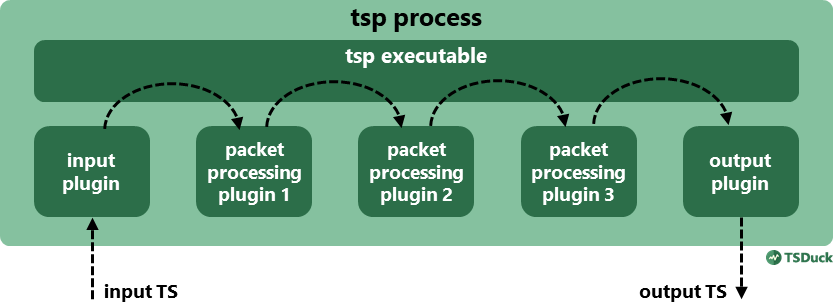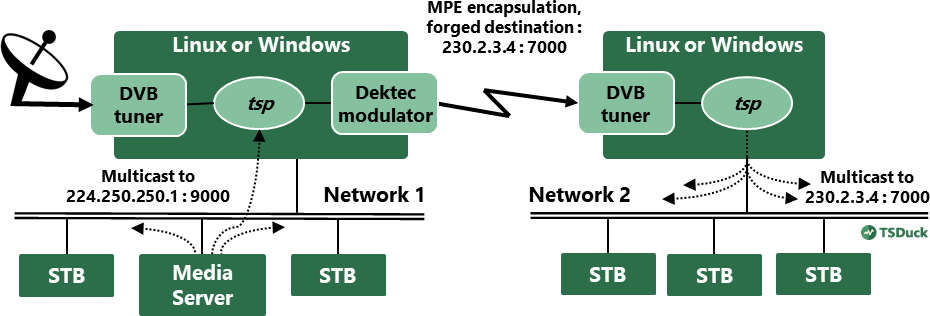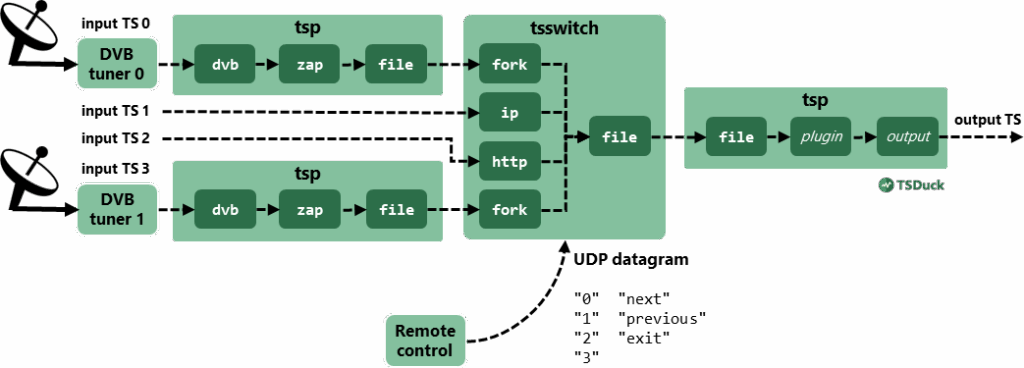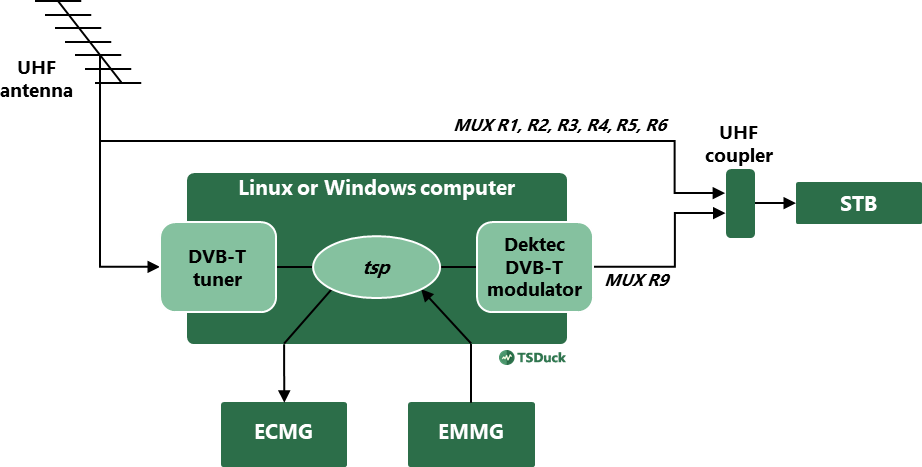- The transport stream processor
- Multi-Protocol Encapsulation (MPE) demo
- Merging and forking transport streams
- A Conditional Access System (CAS) test bed
- The PSI/SI table compiler
TSP, the transport stream processor
The most important TSDuck tool is tsp, the transport stream processor. It is a flexible transport stream processing framework. Running tsp is a combination of elementary processing operations using plugins.
In each invocation of tsp, there are:
- One input plugin which receives a TS from various possible sources.
- Any number of packet processing plugins which can perform any transformation on the packets in transit.
- One output plugin which sends the TS to various possible destinations.
This is illustrated in the diagram below:

The currently existing input and output plugins can work on TS files, UDP/IP (multicast or unicast, including pcap files), HTTP, HLS, SRT, RIST, DVB/ATSC/ISDB sources using cheap tuners, professional Dektec modulators and ASI devices, HiDes and VATek-based modulators.
MPE injection and extraction
This example describes a test bed or demo infrastructure for MPE injection and MPE extraction.
The network infrastructure is illustrated in the diagram below.

In network 1, a media server multicasts a transport stream on address 224.250.250.1, port 9000. We want to encapsulate this UDP multicast stream in an existing transport stream using MPE. This existing TS is a live satellite feed which is received using a DVB tuner.
We also change the multicast destination address for the UDP stream to 230.2.3.4, port 7000, in the MPE-encapsulated datagrams. There is no particular reason for this, we just illustrate the feasibility.
The resulting transport stream with embedded MPE is then broadcast. Here, the broadcast network is a Dektec modulator, followed by another computer using a DVB tuner.
This computer is connected to a second network. Another instance of tsp extracts the datagrams from the MPE stream and multicasts them on its network using the modified destination address.
The first tsp command adds two services in the existing transport stream. One service carries the IP/MAC Notification Table (INT). The other one carries the MPE stream. We create a fully DVB-conformant signalization for these two services.
The second tsp command extracts the MPE stream from the received TS and forwards all decapsulated UDP multicast datagrams on the local network.
This example is fully described in the TSDuck User’s Guide with all details and corresponding commands.
Merging and forking transport streams
Specific plugins such as merge and fork respectively combine and duplicate transport streams. They are designed to route transport streams from and to other applications. When the “other” application is another instance of tsp, we can create complex processing graphs.
This is illustrated in the diagram below.

In addition to tsp, the command tsswitch can be used to switch inputs between a set of transport streams using the same input and output plugins as tsp. Switching between inputs can be performed automatically at the end of each input or through a remote control application. The remote control protocol is extremely simple, based on text messages in UDP datagrams.
This is illustrated in the diagram below.

The remote control can be performed using simple command lines. The Bash shell provides an easy way to redirect output to an UDP message. The following sample commands send UDP messages on port 4444 to system 127.0.0.1 (the local host). This is the easiest way to use the tsswitch remote control.
echo >/dev/udp/127.0.0.1/4444 2
echo >/dev/udp/127.0.0.1/4444 nextA CAS test bed
The following diagram illustrates a real-life example. To test a Conditional Access System and signalization, tsp is used to create a new transport stream from a live source. One real TS is received as input using a cheap USB or PCI DVB-T tuner. This TS and all its services are renamed, creating a “new TS” in the network. To test the CAS, tsp interacts with a real ECMG and a real EMMG using the standard DVB SimulCrypt protocols. One service, initially in the clear, is scrambled. tsp generates the control words, scrambles the content and inserts ECM’s and EMM’s. Finally, a set-top box receives all live transponders plus the new one we create.

Everything is done in one single tsp process. The command is the following. For clarity, the details such as tuning parameters, access criteria, IP addresses and ports, are represented as environment variables.
tsp -I dvb -u $UHF_INPUT \
-P tsrename -t 9 -a \
-P svrename direct8 -i 0x0901 -l 41 -n "Direct 8 Test" \
-P svrename bfmtv -i 0x0903 -l 42 -n "BFM TV Test" \
-P svrename 'i>tele' -i 0x0904 -l 43 -n "i>TELE Test" \
-P svrename virgin17 -i 0x0905 -l 44 -n "Virgin 17 Test" \
-P svrename gulli -i 0x0906 -l 45 -n "Gulli Test" \
-P svrename france4 -i 0x0907 -l 46 -n "France 4 Test" \
-P svrename 0x02FF -i 0x09FF \
-P scrambler GulliTest -e $ECMG -s $SUPER_CAS_ID \
-p $PMT_CADESC_PRIVATE -a $AC \
-b $ECM_BITRATE --pid $ECM_PID \
-P cat -c -a $CAS_ID/$EMM_PID/$CAT_CADESC_PRIVATE \
-P datainject -r -s $MUX_SERVER_PORT \
-b $EMM_MAX_BITRATE -p $EMM_PID \
-O dektec -u $UHF_OUTPUT --convolution 2/3 --guard 1/32
This command is complex but rational.
- The option -I on the first line specifies the input plugin and its arguments. Here, the input plugin is dvb which drives DVB tuners.
- Each option -P specifies a packet processor plugin and its options.
- The plugins tsrename and svrename respectively rename the transport stream and a service.
- The plugin scrambler is a DVB scrambler on one service. It generates control words, interacts with a standard ECMG and insert ECM’s. It also updates the PMT of the service to declare the ECM PID.
- The plugin cat modifies or creates the CAT to declare a new EMM stream.
- The plugin datainject implements a DVB SimulCrypt EMM/PDG inserter. It is used as a server by a standard EMMG to insert EMM’s, just as if it was a MUX.
- Finally, the option -O on the last line specifies the output plugin and its arguments. Here, the output plugin is dektec which drives a Dektec modulator, a PCIe board in the computer.
For more details, refer to the TSDuck User’s Guide.
Of course, such a complex command should be maintained and edited in a shell script. Unless we enjoy retyping it every time…
Because of its modular structure, TSDuck is better used with a flexible shell. On Windows systems, we may use PowerShell or Bash (coming with Cygwin or MSys). DOS command line windows should now be reserved to polymorphic deviants only.
The PSI/SI table compiler
TSDuck provides many ways to manipulate PSI/SI and other types of MPEG tables. Tables can be extracted, examined, injected or modified on the fly using specific plugins for tsp.
Tables can be manipulated in several formats:
- Transport stream files: Sections and tables are extracted (“depacketized“) from or inserted (“packetized“) into TS packets in transport streams.
- Section files: These binary files contain sections. Each section is stored in raw binary format. Sections are simply concatenated without any encapsulation.
- XML files: TSDuck defines a specific XML syntax to represent most standard PS/SI tables and descriptors. XML being a text format, such tables can be edited or created by hand using any text editor.
- JSON files: TSDuck defines an automated XML <=> JSON transformation process. Any data which is defined in XML format can be expressed in JSON format as well.
TSDuck utilities manipulate tables in any of these formats and converts between them. Specifically, the command tstabcomp is a table compiler. It takes XML or JSON source files as input, compiles the tables they contain and output binary section files. Thus, we can create any arbitrary table from scratch and build the corresponding binary sections to inject them in a transport stream. The command tstabcomp is also a table decompiler which can recreate the XML or JSON representation of tables from their binary sections.
More generally, all TSDuck commands can manipulate tables in binary, XML or JSON format equally. Tables can be captured from a live transport stream and directly saved in XML or JSON format. We can then edit these text files to modify the tables and reinject them in any other transport stream.
Sample XML source file
The expected XML input format is fully documented in the TSDuck User’s Guide. Briefly, an input XML file uses <tsduck> as root node. The root node contains any number of tables. The following sample XML file contains the definition for simple (and incomplete) PAT and PMT:
<?xml version="1.0" encoding="UTF-8"?>
<tsduck>
<PAT version="8" transport_stream_id="0x0012" network_PID="0x0010">
<service service_id="0x0001" program_map_PID="0x1234"/>
<service service_id="0x0002" program_map_PID="0x0678"/>
</PAT>
<PMT version="4" service_id="0x0456" PCR_PID="0x1234">
<CA_descriptor CA_system_id="0x0777" CA_PID="0x0251"/>
<component elementary_PID="0x0567" stream_type="0x12">
<CA_descriptor CA_system_id="0x4444" CA_PID="0x0252"/>
<ISO_639_language_descriptor>
<language code="fre" audio_type="0x45"/>
<language code="deu" audio_type="0x78"/>
</ISO_639_language_descriptor>
</component>
</PMT>
</tsduck>
Let’s look at the various steps in a real example. We need to reproduce the case of a broadcast stream (satellite, terrestrial, whatever) with a specially crafted NIT. The plugin nit in tsp provides a convenient way to modify a NIT on the fly. But let’s assume that the modifications we need are so specific that this plugin cannot do what we want.
First, we capture the original NIT from the live stream and save it in XML format:
tsp -I dvb --uhf 24 \
-P tables --pid 16 --tid 0x40 --max 1 --xml nit.xml \
-O drop
Now, we manually edit the XML file using any text editor and apply the specific modifications we need. Then, we can directly inject it in the stream:
tsp -I dvb --uhf 24 \
-P inject nit.xml --pid 16 --replace --stuffing \
-O dektec --uhf 24 --convolution 2/3 --guard 1/32